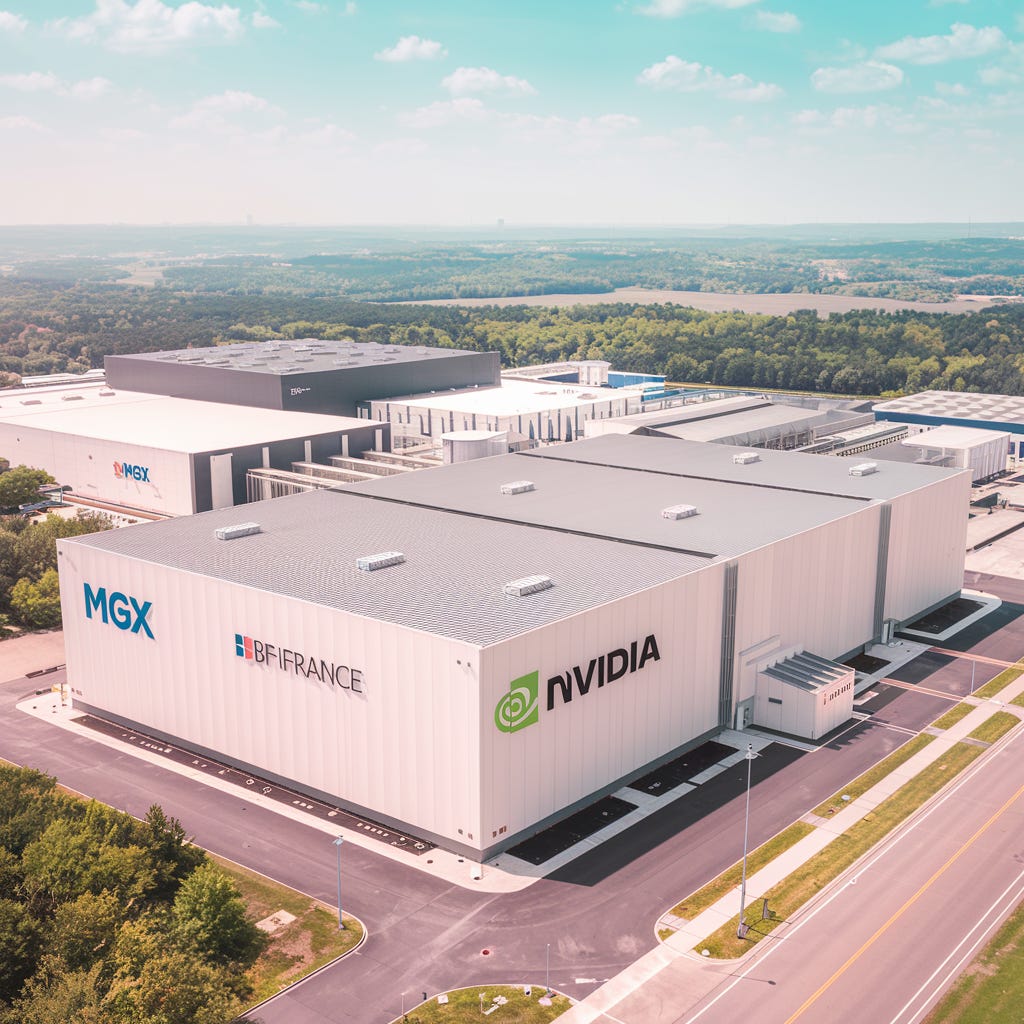Can MGX, Bpifrance, and NVIDIA Reshape Europe’s AI Future with a $9.6B Bet?
The MGX-Bpifrance-Mistral AI-NVIDIA joint venture is more than a mega data center. It’s France’s masterstroke for AI sovereignty and NVIDIA’s backdoor to Europe’s regulatory future.
Welcome to Global Data Center Hub. Join 1700+ investors, operators, and innovators reading to stay ahead of the latest trends in the data center sector in developed and emerging markets globally.
At the 2025 Choose France Summit, a quiet but tectonic shift occurred in the race for AI infrastructure.
NVIDIA, Mistral AI, MGX, and Bpifrance unveiled a €8.5 billion joint venture to build a 1.4 GW mega-campus near Paris the largest AI infrastructure project in Europe’s history.
This isn’t just about scale. It’s about control.
By fusing Gulf capital, French state power, and American compute dominance into a single platform, the four-party consortium is attempting something no U.S. hyperscaler has managed in Europe: local legitimacy, sovereign alignment, and industrial strategy all wrapped in low-carbon infrastructure.
France’s Grand AI Bet
For France, the project solves three problems at once:
Closes the compute gap
French model developers like Mistral AI are outgunned by U.S. labs running tens of thousands of GPUs in proprietary clouds. The Paris campus changes that by offering exascale-class capacity, operated under French law and optimized for foundation model training.Asserts digital sovereignty
The facility will include SecNumCloud-certified partitions, sovereign data zones, and onsite ANSSI audits ensuring that sensitive European data never crosses foreign borders.Kickstarts an industrial flywheel
With waste heat re-use warming 65,000 homes, EDF layering new renewables on top of nuclear baseload, and École Polytechnique co-developing PhDs onsite, this is less a data center and more a national AI factory.
It’s infrastructure as statecraft.
What NVIDIA Gets Out of It
For NVIDIA, this is about geography and geopolitics:
Navigates export controls
With restrictions tightening on advanced GPU sales to China and the Gulf, France offers a strategic workaround a trusted NATO member, a core EU economy, and a country with a proven nuclear-powered grid capable of absorbing 1.4 GW of additional load.Protects European market share
By anchoring its Blackwell architecture in France, NVIDIA secures its European TAM, partners with rising LLM contender Mistral, and embeds itself in a public-private ecosystem away from direct U.S. scrutiny.Avoids building its own data center
This move hedges against both Washington’s policy shifts and hyperscaler lock-in without the capital burden of building out its own infrastructure.
It’s a geopolitically savvy expansion without overextending.
Why MGX Is Betting Big
MGX, the Emirati AI sovereign fund, is the largest equity contributor. Its logic is simple: if AI is the new oil, then France offers a rare combination of grid resilience, regulatory independence, and industrial credibility.
The UAE’s pivot to French soil isn’t just about diversification.
It’s a signal to Washington: we’ll invest in U.S. tech, but we’ll deploy it in geographies where we have equity control and policy leverage.
France gives MGX both especially with a fast-tracked permitting regime and a 25-year EDF power purchase agreement already in place.
The Design Is Built for a Decade, Not a Quarter
The numbers are staggering:
30,000+ Blackwell and Grace Hopper chips
2.5 petabits per second of NVLink Fusion fabrics
14 exabytes of flash-tiered Lustre storage
1.4 GW of compute, backed by 4,600 GWh/year in carbon-free energy
€8.5 billion in upfront capital half of which is already committed
But this isn’t hyperscaler speed. Groundbreaking begins late 2026. Full commercial operations won’t arrive until 2028. And the 1.4 GW milestone won’t hit until 2030.
That delay isn’t a flaw. It’s the point.
France is designing a sovereign, regulated, and sustainable campus that will still matter in ten years not a GPU gold rush that fades after the next architecture upgrade.
This is part of a much larger global financing challenge Who Will Fund the $6.7T Global Data Center Boom? outlines the scale of what’s coming.
What’s at Stake
If the campus succeeds, it gives Europe its first real counterweight to U.S. AI infrastructure dominance. It also creates a platform for open-weight models that don’t live inside Big Tech walled gardens.
But if it fails due to grid constraints, regulatory delays, or governance breakdowns it could sour sovereign ambitions for a decade.
This is no longer about GPUs or training tokens.
It’s about who owns the substrate of AI: compute, energy, policy, and trust.
France just made its move.
For a sharp reminder of how slow-moving approvals and regulatory holdups can stall even the most robust infrastructure plans, see Permitting and Regulatory Delays: The Hidden Threat to Data Center Investors.

